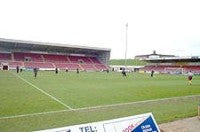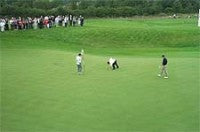Facts about mowing ?
Facts about Mowing?
By Laurence Gale

|

|
With spring approaching, day light hours lengthening and the recent mild weather, flushes of grass growth are being experienced in many parts of the country. Turf managers are initiating early mowing to maintain winter sward heights. Within three weeks we may find ourselves gearing up for the serious mowing season again. This article will detail some key facts on mowing and highlight many issues and facts about the so-called simple act of mowing grass!
Early management of grassland was by farmers who grew grass for animal food crops. However it was not until the late 19th century did we start to see grassland become managed for popular sporting activities particularly golf, football and cricket.
The popularity of grass sports pitches was enhanced by the development of lawn mowers first invented in the early 19th century by an Englishman Edwin Budding, an engineer at a textile mill, who developed a cylinder, or reel-type mower.
In 1870, Elwood McGuire of Richmond, Indiana designed a machine that basically brought push mowing to the masses. By 1885, America was building and exporting 50,000 lawnmowers a year. Today we have millions of lawn and professional turfgrass mowers all offering different cutting techniques and performances, (cylinder, rotary, flail) all of which are used to maintain a determined sward height and turf grass quality.
To be able to determine which type of mower and how often to use it for a given turf facility, it may be necessary to have a better understanding of what we mean by turf grass quality.
Turf grass quality
Turf grass quality will be influenced by soil type; grass species, fertiliser, pesticide and irrigation inputs coupled with good cultural maintenance operations.
Turf grass quality can be broken down into several headings:
| Aesthetic / visual quality: | Turf grass appearance, The number of shoots / tillers per unit area, the denser the turf the better the visual look. |

|
| Texture: | Leaf blade width and texture, coarse and fine grasses (fescue grasses having fine leaf blades compared to smooth stalked meadow grasses that have a wider, more rougher leaf blade). | |
| Colour: | Light reflectance from light green to dark green. Mowing in different directions will develop a nap on the sward which can give you an aesthetic appearance of light and dark shading that is used to good affect when preparing playing surfaces. Also the colour of the sward will be dependant on the time of the year, the growth and vigour of the grass species / seed mixture. |

|
| Growth Habit: | Type of shoot growth stoloniferous, bunch / tufted, rhizomatous (vigorous or slow growing grasses). | |
| Smoothness: | The uniformity of the surface cut area of the sward, grass damaged by poor cutting will not be smooth and may affect visual and playability characteristics of the turf. |

|
| Uniformity: | The sward is consistent, no weeds, bare areas or patches of other grasses | |
| Functional quality: | Rigidity and elasticity, the ability of the sward to resist compression, and its ability to springs back up after ball roll and player activity. |

|
| Resiliency: | The grasses ability to absorb shock, which will be governed by the amount of sward present. | |
| Yield: | The amount of clippings removed during mowing operations can affect grass growth; the removal of too much growth in a single mowing operation or scalping will stress the grass plant. |

|
| Verdure: | The amount of aerial shoots remaining after mowing will determine the appearance of the sward. | |
| Ball roll / ball speed : | Each sport has recommended standards of ball roll; inconsistent sward height and density will affect ball roll. |

|
| Rooting: | The amount of root growth will determine and control the rate of top growth produced, the greater and healthier the root system the greater the ability of the grass plant to recuperate and recover. |
Mowing operations will have a significant effect on turf grass quality:
The choice and type of mowers will be dependant and determined by many factors.
-
Levels of playability
-
Sport surface managed
-
Location, size, and topography
-
Budgets
-
Staff resources
-
Grass species
Height of cut can vary depending on the type of machines used. Closer mowing stimulates aerial shoot growth, increased shoot density and finer texture, but can decrease root and rhizome growth. If the sward is cut too short it will cause scalping and lead the turf plant into stress. Different sports require different heights of cut.
The table below indicates the length of grass cover recommended for the following sports with a range representing high and low level standards.
|
Sport |
Grass Height |
Sport |
Grass Height |
|
Bowling greens: |
3-6mm |
Cricket square: |
6-16mm |
|
Hockey: |
5-20mm |
Cricket pitch: |
2-7mm |
|
Rugby: |
25-65mm |
Cricket outfield: |
8-25mm |
|
Football: |
25-60mm |
Golf greens |
4-8mm |
|
Tennis |
8-16mm |
Golf tees |
10-15mm |
|
Horse racing |
100-120mm |
Golf fairways |
20-30mm |
The type of cutting methods (cylinder, rotary, flail) will affect the sward quality. Cylinder mowers generally produce a finer, sharper cut depending on the number of blades used. For fine turf situations (bowling and golf greens) cylinder mowers with 9 to 12 cylinder blades are generally used. Winter sports pitches 5 to 9 cylinder blades. Badly adjusted mowers will tear and bruise grass leading to leaf tissue damage, which in turn could lead to disease attack through these wounds.

|

|

|
Frequency of cut will also affect turf grass quality; infrequent cutting results in weaker, thinner swards. Equally, mowing down long grass may cause mowers to clog up, affecting the quality and leaving areas uncut. Also, trying to cut too much grass will put extra strain on drive shafts, belts and pulleys, which may result in mower damage.
The affect of over cutting and close mowing of grass swards leads to the grass plant becoming stressed because too much leaf tissue is being removed, reducing the plants capability to produce enough carbohydrates to maintain plant health.
Timing of cutting also affects turf grass quality. Trying to cut the grass in the mornings when there is a heavy dew on the ground or during heavy rain fall will result in poor cutting quality, together with skidding and scuffing damage to the playing surface.
Size and weight and power of mowers also has to be considered. Speed of the machine will dictate how quickly you can mow your facility. The weight of the machines may also affect turf grass quality
Training in mower use is important, to ensure operators are familiar with controls and mowing height settings, and being able to monitor and keep sward height consistent.
If any members have information on mowing techniques and mower product performance relating to their facilities and wish to publish this information please contact laurence@pitchcare.com.
